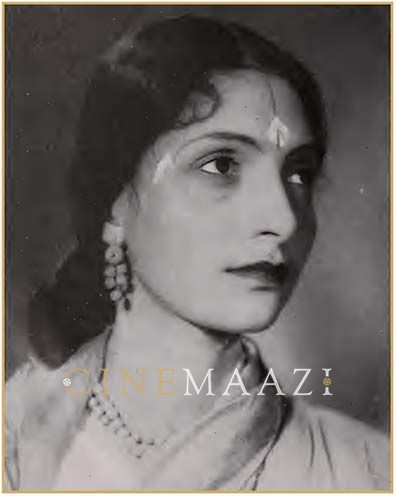Leela Chandragiri

Subscribe to read full article
This section is for paid subscribers only. Our subscription is only $37/- for one full year.
You get unlimited access to all paid section and features on the website with this subscription.
Not ready for a full subscription?
You can access this article for $2 , and have it saved to your account for one year.
- Born: 24 October 1910
- Died: 3 February
- Primary Cinema: Hindi
- Spouse: Bhalji Pendharkar
- Grand Children: Jaysingh, Madhavi
Having acted in more than 40 films in the course of a long career beginning from the early years of Indian cinema, singer-actress Leela Chandragiri (also known as Miss Leela or Lilavati Pendharkar) is known for films such as Agnikankan: Branded Oath (1932), Sairandhri (1933), Akashwani (1934), Maharathi Karna (1944), 1857 (1946), Tamasha (1952), Aandhi Aur Toofan (1964), and Rustom-E-Hind (1965). She mainly featured in Prabhat Film Company productions. Later, declining the opportunity to move to Poona with Prabhat Films, she chose to stay back in Kolhapur and work with noted film personality, Bhalji Pendharkar. The two later married; together they would establish Jayprabha Studio, named after their sons from their respective previous marriages – Jaysingh and Prabhakar.
Born Leela Chandragiri on 24 October 1910 into a family of singers at Chikodi near Kolhapur, she learnt singing from a young age. Catching the attention of the Prabhat Film Company, she made her debut in V Shantaram’s silent film Uday Kaal (1930). Fittingly, the tall and beautiful Leela played goddess Bhawani Devi on screen. Among the early films she featured in are Associated Films’ silent Anadhai Penn/ Orphan’s Daughter (1930) and Signet Ring (1931) both directed by Raja Sandow PK. Her fame grew with Chandrasena (1931) in which she played a key role. This grand silent film directed by V Shantaram and Keshavrao Dhaiber was produced under the banner of the Prabhat Film Company; it brought Prabhat into the frontline of film studios. She featured alongside Kamla, Baburao, Jal, Gulabbai and G. R. Mane in the film which portrayed an episode from the epic Ramayana, wherein Mahiravan's wife, Chandrasena helps Hanuman to rescue Rama and Lakshmana from Patala and, in the process, defeat Mahiravana's army.
She would go on to star in several of Prabhat's films, often credited as Leela or Miss Leela. Agnikankan: Branded Oath (1932) saw her star in the V Shantaram action drama about a king who is overthrown by the perfidy of his villainous commander; however, the young prince defeats the villain, reclaims the throne and restores his father's honour.
Her first talkie, Jalti Nishani (1932), a Marathi-Hindi bilingual starring Master Vinayak, saw her fluently delivering dialogues in both languages. Combined with her singing talent, she quickly became a favourite of audiences.
Shantaram’s Maya Machhindra (1932) saw her star alongside Govindrao Tembe, Durga Khote and Master Vinayak in the film based on the Tantric legend about the guru Machhindranath and his disciple Gorakh on the subject of maya (belief in the illusory nature of worldly temptations).
In 1933, she featured in the historical film directed by Shantaram, based on Hari Narayan Apte's literary classic novel of 1904 - Gad Ala Pan Sinha Gela (I Won The Fort But Lost A Lion). The cast included Master Vinayak, Baburao Pendharkar, Keshavrao Dhaiber, Shinde, Prabhavati, Budasaheb and Shankarrao Bhosle. The plot revolved around Chhatrapati Shivaji's lieutenant, the Koli folk-hero Tanaji Malusare.
The same year, she essayed the lead role in the Shantaram-directed Sairandhri, based on an episode from the Mahabharata. Made as a bilingual in Marathi and Hindi, it has been cited as one of the 21 "most wanted missing Indian treasures" by P K Nair, founder of the National Film Archive of India. With a cast that included Master Vinayak, Prabhavati, Shakuntala, G R Mane, Nimbalkar and Shankarrao Bhosle, it was also reportedly the first Indian colour film. Shot on Agfa B&W 35-mm negative, the release prints were made in Germany by Bipack colour printing process. The film told the story of Draupadi as Malini/Sairandhari (female servant), the 13th identity she took in order to remain safe and hidden from the Kauravas.
Other films she featured in include Kolhapur Cinetone's Akashwani (1934), Saraswati Cinetone's Savitri (1936), Raja Gopichand (1938), Alakh Niranjan (1940), Bhakt Damaji (1942), Maya Machhindra (1932), Maharathi Karna (1944), and Chhatrapati Shivaji (1952). Her career endured over the decades, with films such as Chhai (1950) and Tamasha (1952), Aas Ka Panchhi (1961), Bandini (1963), and Kettikaran (1971) and Dil Ka Heera (1979).
On the personal front, she married Dadasaheb Phalke award-winning filmmaker Bhalji Pendharkar; it was the second marriage for both. Her two children from her previous marriage, Jaysingh and Madhavi, were adopted by Pendharkar. She and Pendharkar later founded Jayprabha Studios. In 2009, a book was released by Pendharkar’s son, filmmaker Prabhakar Pendharkar titled Eka Studioche Atmavrutta which narrated the story of Jayprabha Studios, from the time of its establishment till date.
Chandragiri passed away on 3 February ___. She remains memorable as a singing star of the early talkie era.
-
Filmography (1)
SortRole
-
Chandrasena 1931
-







.jpg)



